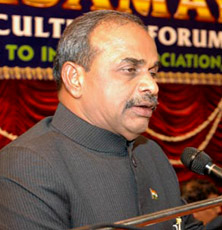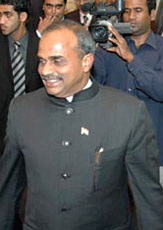The Indian National Congress (Hindi: भारतीय राष्ट्रीय कांग्रेस) (also known as the Congress, and abbreviated INC) is a major political party in India. Founded in 1885 by Allan Octavian Hume, Dadabhai Naoroji, Dinshaw Wacha, Womesh Chandra Bonnerjee, Surendranath Banerjee, Monomohun Ghose, Mahadev Govind Ranade[1] and William Wedderburn, the Indian National Congress became the leader of the Indian Independence Movement, with over 15 million members and over 70 million participants in its struggle against British rule in India. After independence in 1947, it became the nation's dominant political party, led by the Nehru-Gandhi family for the most part, major challenges for party leadership have only recently formed.
In the 2009 general elections, the Congress emerged as the single largest party in the Lok Sabha, with 206 of its candidates getting elected to the 543-member house. Consequently, it along with a coalition of allies called the United Progressive Alliance (UPA), was able to gain a majority and form the government.
History
The history of the Indian National Congress falls into two distinct eras:
- The pre-independence era, when the party was at the forefront of the struggle for independence and was instrumental in the whole of India;
- The post-independence era, when the party has enjoyed a prominent place in Indian politics, ruling the country for 48 of the 60 years since independence in 1947.
In the pre-independence era, the congress was divided in two groups, moderate and activist. The moderates were more educated and wanted to win people's faith to lead the nation to independence without bloodshed.the activists however wanted to follow a revolutionary path and make it a militant organization.
The pre-independence era
Founded in 1885 with the objective of obtaining a greater share in government for educated Indians, the Indian National Congress was initially not opposed to British rule. The Congress met once a year during December. Indeed, it was a Scotsman, Allan Octavian Hume, who brought about its first meeting in Bombay, with the approval of Lord Dufferin, the then-Viceroy.
Womesh Chandra Bannerjee was the first President of the INC. The first meeting was scheduled to be held in Pune, but due to a plague outbreak there, the meeting was later shifted to Bombay. The first session of the INC was held from 28–31 December 1885, and was attended by 72 delegates.
A few years down the line, the demands of INC became more radical in the face of constant opposition from the government, and the party became very active in the independence movement. By 1907 the party was split into two halves: the Garam Dal (literally "hot faction") of Bal Gangadhar Tilak, or Extremists , and the Naram Dal (literally "soft faction") of Gopal Krishna Gokhale, or Moderates , distinguished by their attitude towards the British. Under the influence of Bal Gangadhar Tilak, the Congress became the first integrated mass organization in the country, bringing together millions of people against the British. The Indian National Congress was the only political party to provide harmony to all the sects of the Indian society[citation needed]
In its time as the nation's leader in the freedom struggle, it produced the nation's greatest leaders. Before the Gandhi Era came leaders like Bal Gangadhar Tilak, Bipin Chandra Pal, Lala Lajpat Rai, Gopal Krishna Gokhale, Mohammed Ali Jinnah (later leader of the Muslim League and instrumental in the creation of Pakistan), all starting with the first legendary icon of Indians: Dadabhai Naoroji, the president of the sister Indian National Association and later the first Indian Member of Parliament in the British House of Commons. The Congress was transformed into a mass movement by Surendranath Banerjea and Sir Henry Cotton during the partition of Bengal in 1905 and the resultant Swadesi Movement. Gandhi came back from South Africa in 1915 and with the help of the moderate group led by Ghokhale became the President of the Congress and formed an alliance with the Khilafat Movement. In protest a number of leaders went out of Congress. Khilafat movement ended up in a disaster and the Congress was split. A number of leaders Chittaranjan Das, Annie Besant,Motilal Nehru, went out of The Congress to set up the Swaraj Party.
With the rise of Mahatma Gandhi's popularity and his Satyagraha art of revolution came Sardar Vallabhbhai Patel, Pandit Jawaharlal Nehru (the nation's first Prime Minister), Dr. Rajendra Prasad (the nation's first President), Khan Mohammad Abbas Khan, Khan Abdul Ghaffar Khan, Chakravarti Rajgopalachari, Jivatram Kripalani and Maulana Abul Kalam Azad. With the already existing nationalistic feeling combined with Gandhi's popularity the Congress became a forceful mass organization in the country, bringing together millions of people by specifically working against caste differences, untouchability, poverty, and religious and ethnic boundaries. Although predominantly Hindu, it had members from virtually every religion, ethnic group, economic class and linguistic group. In 1939,Subhas Chandra Bose, the elected president in both 1938 and 1939 was expelled from the Congress for his socialist views and The Congress was reduced to a pro-Business group financed by the business houses of Birla and Bajaj. At the time of the Quit India movement, the Congress was undoubtedly the strongest political and revolutionary organization in India, but the Congress disassociated itself from the Quit India movement within a few days. The Indian National Congress could not claim to be the true representative of the Indian people as other parties were there as well particularly theHindu Mahasabha, Azad Hind Sarkar, Forward Bloc.
The 1929 Lahore session under the presidency of Jawaharlal Nehru holds special significance as in this session "Poorna Swaraj" (complete independence) was declared as the goal of INC. 26 January 1930 was declared as "Poorna Swaraj Diwas," Independence Day although the British remained in India a number of years longer. It was to commemorate this date particularly that The Indian Constitution was formally adopted on 26 January 1950 (even though it was passed on 26 November 1949).However in 1929 Srinivas Iyenger was expelled from the Congress for demanding full independence, not justhome rule as demanded by Gandhi.
After the First World War the party became associated with Mahatma Gandhi, who remained its unofficial, spiritual leader and mass icon even as younger men and women became party president. The party was in many ways an umbrella organization, sheltering within itself radical socialists, traditionalists and even Hindu and Muslim conservatives, but all the socialists (including the Congress Socialist Party, Krishak Praja Party, Swarajya Party members) were expelled along with Subhas Chandra Bose in 1939 by Gandhi.
Members of the Congress initially supported the sailors who led the Royal Indian Navy Mutiny. However they withdrew support at the critical juncture, when the mutiny failed.
During the INA trials of 1946, the Congress helped to form the INA Defence Committee, which forcefully defended the case of the soldiers of the Azad Hind government. The committee declared the formation of the Congress' defence team for the INA and included famous lawyers of the time, including Bhulabhai Desai, Asaf Ali, and Jawaharlal Nehru.


 YSR entered active politics in 1978. He contested in four elections to be a part of the State Legislative Assembly and contested the same number of times to become a Member of the Lower House of Parliament. YSR had won all the elections in which he had participated. Reddy had an eventful 25-year political career which he started as a samithi president and later served as a youth congress leader. At the age of 28, he won the ensuring elections in the year 1978 with the ticket of the Indian National Congress. For a brief period he served as minister in Tanguturi Anjaiah cabinet. Then the Prime Minister, Indira Gandhi entrusted the potential leader with as the Pradesh Congress Committee president at the age of 34. For four times Dr. Reddy represented Kadapa constituency as Member of Parliament of India and as a Member of Legislative Assembly of Andhra Pradesh and also same number of times from the Pulivendula constituency. The timeline of his political career unfurls the fact that Reddy had never lost a single election.
YSR entered active politics in 1978. He contested in four elections to be a part of the State Legislative Assembly and contested the same number of times to become a Member of the Lower House of Parliament. YSR had won all the elections in which he had participated. Reddy had an eventful 25-year political career which he started as a samithi president and later served as a youth congress leader. At the age of 28, he won the ensuring elections in the year 1978 with the ticket of the Indian National Congress. For a brief period he served as minister in Tanguturi Anjaiah cabinet. Then the Prime Minister, Indira Gandhi entrusted the potential leader with as the Pradesh Congress Committee president at the age of 34. For four times Dr. Reddy represented Kadapa constituency as Member of Parliament of India and as a Member of Legislative Assembly of Andhra Pradesh and also same number of times from the Pulivendula constituency. The timeline of his political career unfurls the fact that Reddy had never lost a single election.  Even as a beginner in the legislature, on the demand of the solution to the water causes YSR rallied all the Congress MLAs from the Rayalaseema region and led an indefinite hunger strike. He also took up padayatra for 64 days that stretched to an extent of 1500 km from Chevella in the Telengana to Ichchapuram in Srikakulam district in the summer of 2003. In order to protest against the hike in power charges the 14 day hunger strike which Reddy carried out is still afresh. His Yatra took him closer to the poor and rural people and at the same time, it was well received by all the sections of the society.
Even as a beginner in the legislature, on the demand of the solution to the water causes YSR rallied all the Congress MLAs from the Rayalaseema region and led an indefinite hunger strike. He also took up padayatra for 64 days that stretched to an extent of 1500 km from Chevella in the Telengana to Ichchapuram in Srikakulam district in the summer of 2003. In order to protest against the hike in power charges the 14 day hunger strike which Reddy carried out is still afresh. His Yatra took him closer to the poor and rural people and at the same time, it was well received by all the sections of the society.